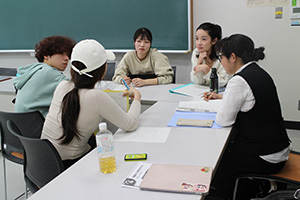Check the QR code to the right for more information on the application period and materials.
Japanese Language Classes for International Students
Okinawa International University offers Japanese language and culture classes for foreigners who enter Japan to study at a Japanese university.
Japanese Classes Offered by Level(a partial list)
| credits | Hours/Week | Content | ||
|---|---|---|---|---|
| Beginner | Beginning Japanese I A | 2 | 4 | Students learn basic sentence patterns and how to communicate in everyday situations using the famous Minna no Nihongo textbook. They also aim to expand their vocabularies and improve their expression, conversation, and communication abilities. |
Beginning Japanese I B | 2 | 4 | ||
Beginning Japanese II A | 2 | 4 | ||
Beginning Japanese II B | 2 | 4 | ||
Pre-Intermediate Comprehensive Japanese I A | 2 | 4 | Students learn to express themselves in Japanese by discussing their experiences, feelings, and ideas on various topics. They also deepen their understanding of themselves and others by comparing Okinawa’s history and culture to those of their own countries. In addition, they learn to experience the joy of reading Japanese. | |
Pre-Intermediate Comprehensive Japanese I B | 2 | 4 | ||
Pre-Intermediate Comprehensive Japanese II A | 2 | 4 | ||
Pre-Intermediate Comprehensive Japanese II B | 2 | 4 | ||
| Intermediate | Intermediate Japanese Listening Comprehension and Conversation I | 2 | 4 | Students work on their listening and communication skills, while aiming to master honorifics and polite language. They also learn to convey information in Japanese, especially in their daily lives as international students. |
Intermediate Japanese Listening Comprehension and Conversation II | 2 | 4 | ||
Japanese Grammar I | 2 | 4 | Students learn intermediate grammar and expressions. Students familiarize themselves with the grammar in conversation and speech by practicing sentence patterns in various situations. | |
Japanese Grammar II | 2 | 4 | ||
Advanced Japanese Culture and Society I | 2 | 4 | Students learn about Japanese and Okinawan history, politics, education, culture, performing arts, and sports. They then express their opinions, ask questions, and exchange ideas with classmates about similarities and differences between their own countries. | |
Advanced Japanese Culture and Society II | 2 | 4 | ||
Intermediate Japanese Composition I | 2 | 4 | Students learn how to write logical compositions and essays. They also learn to organize their essays into paragraphs, express supporting or opposing opinions, and summarize arguments and opinions. | |
Intermediate Japanese Composition II | 2 | 4 | ||
| Advanced | Japanese Grammar III | 1 | 2 | Students focus on grammar on Levels N1 and N2 of the Japanese-Language Proficiency Test to acquire the ability to solve problems that appear on those tests. |
Japanese Grammar IV | 1 | 2 | ||
Japanese Expression I | 1 | 2 | Students learn how to develop their ideas into logical, well-organized essays. In addition to improving their academic skills, students aim to improve their Japanese language ability. | |
Japanese Expression II | 1 | 2 | ||
Advanced Japanese Seminar I | 2 | 4 | Students improve their overall Japanese skills by reading newspaper articles on various topics, creating outlines, and giving presentations to explain the content and express their opinions. | |
Advanced Japanese Seminar II | 2 | 4 |
Credited Auditing System for International Students
Foreign credited auditors are international students who take Japanese subjects to improve their Japanese ability to the level needed to enter a Japanese university.
Application Requirements
Applicants must meet the first two conditions (1 and 2) and one of the remaining conditions (3 through 5).
(1) The applicant possesses a Status of Residence of “Student,” as defined in the Immigration Control
and Refugee Recognition Act, for the purpose of entering a university or studying in Japan.
(2) The applicant must meet one of the following two conditions:
● Receive a score of 200 or above on the Reading Comprehension, Listening, and Listening-Reading
Comprehension section of the Japanese as a Foreign Language subject of the Examination for
Japanese University Admission for International Students (EJU).
● Pass Level N2 or above on the Japanese-Language Proficiency Test (JLPT).
(3) The applicant completed a 12-year course of study in a foreign country or its equivalent, as designated
by the Minister of Education, Culture, Sports, Science and Technology.
(4) The applicant completed a course at an overseas educational institution equivalent to a high school
course, as designated by the Minister of Education, Culture, Sports, Science and Technology.
(5) The applicant’s qualifications are equivalent to those listed in 3 and 4 above, as recognized by OKIU.
※ Applications cannot be submitted from outside Japan. ※ Support for acquiring a visa is not provided.
Expenses
¥11,500 per credit (First-semester course fees must be paid before the enrollment submission deadline.)
※ Costs are subject to change.
Foreign credited auditors are international students who take Japanese subjects to improve their Japanese ability to the level needed to enter a Japanese university.
Application Requirements
Applicants must meet the first two conditions (1 and 2) and one of the remaining conditions (3 through 5).
(1) The applicant possesses a Status of Residence of “Student,” as defined in the Immigration Control
and Refugee Recognition Act, for the purpose of entering a university or studying in Japan.
(2) The applicant must meet one of the following two conditions:
● Receive a score of 200 or above on the Reading Comprehension, Listening, and Listening-Reading
Comprehension section of the Japanese as a Foreign Language subject of the Examination for
Japanese University Admission for International Students (EJU).
● Pass Level N2 or above on the Japanese-Language Proficiency Test (JLPT).
(3) The applicant completed a 12-year course of study in a foreign country or its equivalent, as designated
by the Minister of Education, Culture, Sports, Science and Technology.
(4) The applicant completed a course at an overseas educational institution equivalent to a high school
course, as designated by the Minister of Education, Culture, Sports, Science and Technology.
(5) The applicant’s qualifications are equivalent to those listed in 3 and 4 above, as recognized by OKIU.
※ Applications cannot be submitted from outside Japan. ※ Support for acquiring a visa is not provided.
Expenses
¥11,500 per credit (First-semester course fees must be paid before the enrollment submission deadline.)
| First Semester | Second Semester | |
|---|---|---|
| Course Fee | \92,000 | \92,000 |
| Student Insurance Fee | \1,340 | - |
| Total Payment | ¥93,340 | ¥92,000 |




